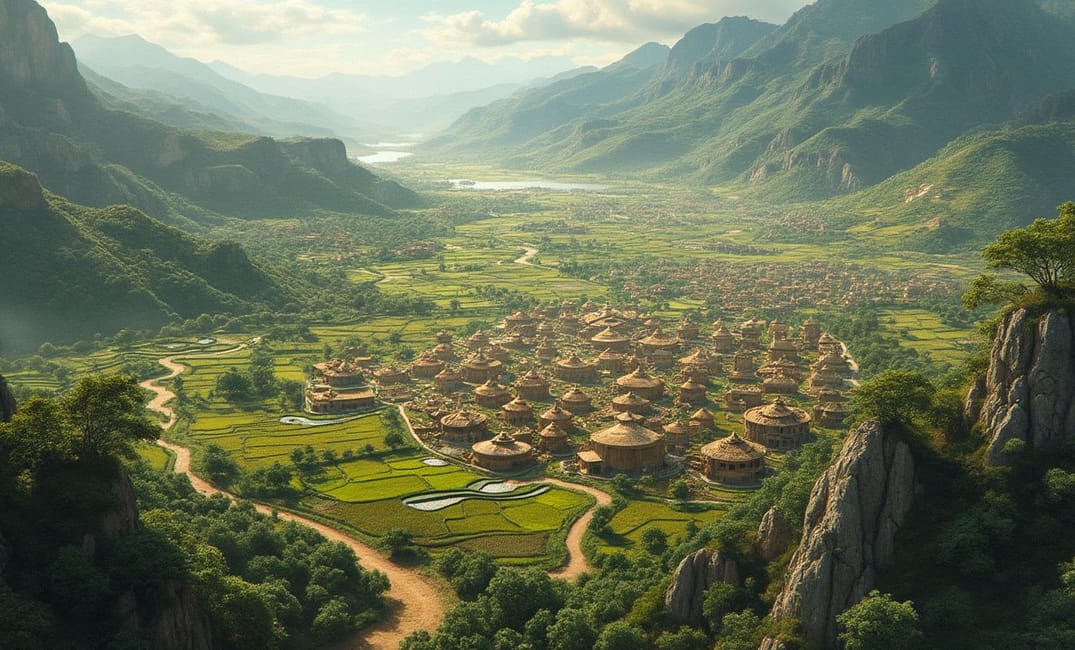Introduction: Cultivating the Seeds of Society
Agriculture marks one of human history's most significant milestones, a transformative force that shifted nomadic lifestyles to settled civilization. Its innovation in planting and harvesting not only sustained burgeoning populations but also ignited social complexity, economic networks, and technological advances. The story of agriculture is interwoven with that of humanity's ascent—a saga of adaptation, ingenuity, and impact resonating through millennia.
The Fertile Ground of Beginnings
Agriculture's roots can be traced back to the end of the last Ice Age, as climatic shifts inspired a revolution in subsistence strategies across various regions.
The Neolithic Revolution
- Domestication Dawn: Around 10,000 BCE, regions like the Fertile Crescent, the Indus Valley, China, and Mesoamerica witnessed the pioneering domestication of plants and animals. Wheat, barley, rice, and maize—staples of early agriculture—revolutionized food sources and allowed communities to establish permanent settlements.
- Techniques Trialed and True: Early farmers experimented with techniques like crop rotation, irrigation, and selective breeding, gradually mastering the art and science of agriculture. This careful stewardship of land and yield catalyzed societal stability, resource accumulation, and population growth.
Irrigation Innovations
- Harnessing Rivers: Civilizations flourished along mighty rivers like the Nile, Tigris-Euphrates, and Yangtze, which supported intricate irrigation systems. This ingenuity reshaped landscapes, forging a nexus between water control, agricultural surplus, and societal complexity.
- Terrace Cultivation: Highland regions such as the Andes embraced terrace farming, a technique preserving soil fertility and managing water resources on steep terrains. This method epitomized human resilience and adaptation, foundational to enduring agricultural practices.
The Growth of Agricultural Societies
The proliferation of agriculture drove complex societal structures, shaping governance, trade, and cultural exchange.
The Rise of Early Civilizations
- City-States and Kingdoms: The surplus generated by agriculture supported urban centers and emergent civilizations such as Mesopotamia, Ancient Egypt, and the Harappan society. These states wielded political power and organized labor—establishing the framework for future governance.
- Class Stratification and Specialization: Agriculture's productivity facilitated social stratification, allowing specialized roles beyond mere subsistence farming. Artisans, priests, and traders emerged, enriching cultural and technological landscapes, thereby advancing human progress.
Networks of Trade and Exchange
- Agricultural Commodities and Trade: Agrarian societies produced surpluses that fueled extensive trade networks connecting distant cultures. Goods such as grains, spices, and textiles exchanged via the Silk Road and other routes fostered economic interdependence and cultural diffusion.
- Cultural Interactions and Innovations: The exchange of agricultural practices and crop varieties spurred technological innovations and culinary diversity. Crops spread between continents evolved into integral facets of cultural identity and economic vitality.
Transformations Across Medieval and Modern Ages
The evolution of agriculture continued to mold societies through technological advancements and societal shifts.
Medieval Transformations
- Feudal Systems and Manorial Economy: In medieval Europe, the manorial system organized agriculture within feudal structures, with serfs cultivating lands for lords. Innovations like the heavy plow and three-field crop rotation boosted yield and sustainability.
- Asian Agricultural Evolutions: Regions in Asia developed highly efficient agricultural systems, epitomized by rice paddies and intensive labor. These innovations underpin thriving populations and cultural continuities across the Asian continent.
Agricultural Revolution and Industrial Age
- Mechanization and Productivity: The 18th-century Agricultural Revolution introduced mechanization in Britain, with inventions like the seed drill enhancing productivity. These advances preluded industrial transformations, enabling vastly increased agricultural efficiency and urban migrations.
- Chemical Fertilizers and Genetic Advancements: The 20th-century Green Revolution employed chemical fertilizers and high-yield crop varieties, revolutionizing agriculture in regions like India and Mexico. These advances resolved food crises but raised ecological and ethical considerations.
Contemporary Agriculture: Challenges and Opportunities
Modern agriculture faces unprecedented challenges and opportunities, demanding innovation and stewardship for a sustainable future.
Sustainable Practices and Technological Integration
- Precision Agriculture and Biotechnology: Emerging technologies, including GPS-guided machinery and genetically modified organisms (GMOs), offer promising avenues for efficient, sustainable farming. Precision agriculture tailors practices to individual field conditions, optimizing resources and yield.
- Agroecology and Organic Movements: Movements towards organic farming and agroecology advocate for holistic approaches that harmonize with natural systems. These methods preserve biodiversity, soil health, and ecological balance, representing sustainable alternatives to industrial agriculture.
Global Challenges and Food Security
- Climate Change Impacts: Agriculture faces significant threats from climate change, manifesting as unpredictable weather, soil degradation, and water scarcity. Resilient systems and adaptive strategies are paramount in ensuring robust, food-secure futures.
- Equity and Global Agendas: While technology offers transformative potential, equitable access and ethical considerations are crucial. Supporting smallholder farmers, fostering equitable trade policies, and prioritizing indigenous knowledge promote sustainable, inclusive agricultural paradigms.
Conclusion: Sowing the Seeds of Tomorrow’s Harvests
Agriculture’s odyssey reflects humanity’s indomitable spirit, creative adaptability, and capacity for transformation. As civilization embraces future challenges, the lessons and legacies of agrarian pasts will illuminate pathways towards shared sustenance, resilience, and prosperity. The future promises bountiful landscapes where innovation, stewardship, and collaboration sow the seeds of sustainable success.
SUSTAINABILITY, HISTORY, CLIMATE CHANGE, FOOD SECURITY, TRADE, CULTURAL EXCHANGE, TECHNOLOGY, AGRICULTURE, INNOVATION, CIVILIZATIONS

